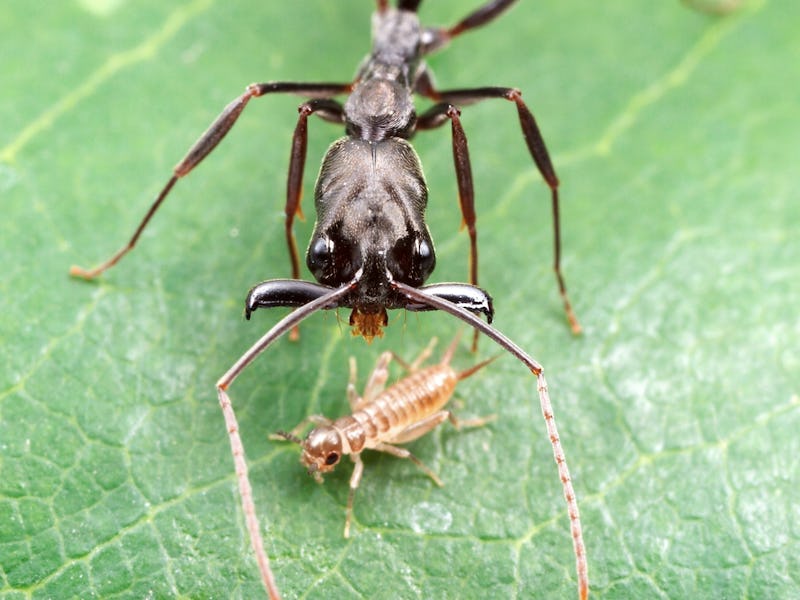Trap-jaw ants are so powerful they should implode — scientists finally uncovered their secret
The insects evolved special jaws to prevent the animals from destroying themselves.

Trap-jaw ants can slam their jaws together with extraordinary speed, with the tips of their mandibles racing at up to roughly 120 miles per hour. How they could perform such attacks, repeatedly, without destroying themselves has long been a mystery to biologists.
Now, in a new study published July 21 in the Journal of Experimental Biology, scientists found that trap-jaw insects evolved jaws they simultaneously push and pull together with remarkable force, while moving in perfect arcs that help keep the insects from ripping themselves apart.
HERE'S THE BACKGROUND — Trap-jaw ants (Odontomachus brunneus) can move their chopstick-like mandibles slowly and dexterously. However, they can also crash their jaws together staggeringly rapidly, striking victims in roughly three-quarters of a millionth of a second. They can perform these strikes dozens of times in succession without visible damage to either their jaws or their head.
The key to such attacks is a jaw design that acts much like a catapult. As a latch holds each mandible in place, muscles in their head contract, storing energy like springs. When the ants release these latches, all this energy gets released at once. Similar mechanisms drive mantis shrimp punches, which are likely the fastest in the animal kingdom, striking at speeds of up to roughly 70 miles per hour.
They can also crash their jaws together staggeringly rapidly, striking victims in roughly three-quarters of a millionth of a second...without visible damage to either their jaws or their head.
However, many of these latch-based mechanisms seen in nature use multiple springs. For example, when trap-jaw ants contract their head muscles, this energy gets stored in two areas—their head's exoskeletal capsule, and the tendon-like structure attaching each jaw to enormous jaw muscles that altogether comprise 14 percent of the ant's body mass.
"It was not understood what advantage the two-spring construction had over a construction with only one spring," study lead author Gregory Sutton, a biomechanist at the University of Lincoln in England, tells Inverse.
WHAT DID THE SCIENTISTS DO? — To shed light on the secrets of this insect's lightning-fast strikes, researchers secured trap-jaw ants in front of a high-speed camera filming at 300,000 frames per second. They also created 3-D models of the ants using micro-CT scans of the insects and by measuring the weights of their jaws and head capsule down to a hundredth of a millionth of a gram.
A slow-motion movie of a trap-jaw ant (Odontomachus brunneus) releasing its mandibles. Reproduced with permission of The Company of Biologists.
WHAT DID THEY FIND? — Before each attack, jaw muscle contractions deformed the head capsule, shortening it by 64 microns, or 3.2 percent, and squeezing it inward by 41 microns, or 6 percent. At the same time, the jaw muscle also stretched the ant's tendon-like structure, building up tension. When the insects unleashed a strike, the head capsule decompressed, pushing the jaw, while the tendon-like structure contracted, pulling the jaw.
These motions led each jaw to pivot in a precise circular arc centered around each mandible's fragile joint, a motion "that requires no additional force at the joint to hold the mandible in place," Sutton says. "This would be akin to muscles moving your forearm at an incredibly high speed while doing so in such a way that there was no stress on your elbow."
This perfect arc enables "both mandibles to come together to do catastrophic damage to a targeted insect, but to do in such a way that causes no forces on the joint at the center of that arc," Sutton says. "The circular arc maximizes the damage to the prey while minimizing any wear or tear on the striking ant."
Calculating the amount of energy released from these dual springs, the team discovered the head capsule's energy drove the mandibles through 33 degrees of rotation, while the tendon-like structure powered the remaining 32 degrees. All in all, the jaws hurtled at each other with a top rotation speed of 470,000 rpm.
"Prior to this study, the two-spring mechanism had been observed several times, but nobody knew what the advantage was," Sutton says. "Our study shows that the two-spring mechanism reduces wear and tear at the joint, and reduces the friction, allowing these systems to move extremely quickly."
WHAT'S NEXT? — Although the researchers have figured out why these ants use two springs, "we still have a lot of unanswered questions about the materials the springs are made of, how the springs evolved, and the trade-offs involved in deploying these springs," Sutton says.
In addition, there are many ways in which other animals may arrange such dual-spring mechanisms. "These other arrangements will have different advantages and disadvantages, and we're pretty sure that we're only beginning to find out the intriguing and neat ways nature uses springs to drive motion," Sutton says.
These designs could help inspire engineers to develop microrobotic systems "that move faster and more precisely while reducing wear and tear on the joints," Sutton says. The fact that "these everyday animals have so much to teach us about machine component design, among other things, is something that should humble us humans a bit," he adds.
This article was originally published on